Worried about spiders in Fort Worth, Texas? Well, there are 10 that make the list here, with other non-native species probably in the mix as well. If you’re an arachnophobe, and it’s hard to blame you, ’10 spiders’ probably not what you wanted to hear.
Worse yet, the winter is when you have to worry the most, especially since people tend to stay indoors more while the cold season is upon us. Spiders are like most animals, seeking water, food, and shelter, especially when the temperatures drop. Can you blame them? Your home is so warm and cozy, an excellent place to start a family.
Some of the spiders on this list are not the nicest spiders in the world, either. Even worse, some of them are capable of putting you in the hospital. While Texas isn’t the spider capital of the world, they have their fair share in the Lone Star State.
1. Brown Recluse

The brown recluse spider is often identified by the violin-shaped marking on its body.
©Nick626/Shutterstock.com
We may as well get the worst of the spiders in Fort Worth out of the way first. The brown recluse spider consistently ranks as the worst or most poisonous spider in the United States, and for good reason. A bite from the brown recluse leads to swelling, necrosis of the surrounding flesh, pus, an ulcerated sore, and sometimes leads to kidney and liver failure.
The worst part is that the initial bite is barely perceptible, which makes the brown recluse even worse since victims of its bite don’t go to the hospital. The brown recluse is very small, maxing out at a quarter of an inch. Thanks to their preference for dark, out-of-the-way corners and their brown, “blend-in” body, they’re hard to spot until it’s too late.
2. Black Widow

Black widow spider caught in a mason jar.
©Jeff Cleveland/Shutterstock.com
Though the brown recluse is probably the more dangerous of the two, the black widow has a more infamous aura. Perhaps it’s because of its shiny, liquid black aesthetic, with the bright red hourglass formation on its abdomen. There’s little doubt that the black widow has an insidious look, and it is known for causing immense harm, though it’s rare.
Black Widow spiders in Fort Worth are just as frightening as they are anywhere else. Full-grown, they are twice as large as brown recluse spiders, and their venom is altogether different from the latter as well. The venom from the black widow attacks the nervous system, causing internal pain (usually in the abdomen), nausea, vomiting, severe headaches, and, very rarely, death.
3. Yellow Sac Spider

Yellow Sac Spider sitting in a tree.
©Rainer Fuhrmann/Shutterstock.com
You can say what you like about black widows and brown recluses, but the yellow sac spider just sounds like a terrifying abomination straight out of a Hollywood script or horror novel. Even worse, they’re tiny and poisonous. They are often confused with brown recluse spiders, especially when their yellowish appearance has a darker hue.
Fortunately, though the bite from a yellow sac spider is poisonous, it’s not in the same league as the first two spiders on our list. Their bite isn’t particularly painful, either, compared to that of a yellow jacket. However, out of all the spiders in Fort Worth, the yellow sac spider has the nastiest-looking fangs of the bunch. Avoid looking at its mouth under a microscope.
4. Hobo Spider
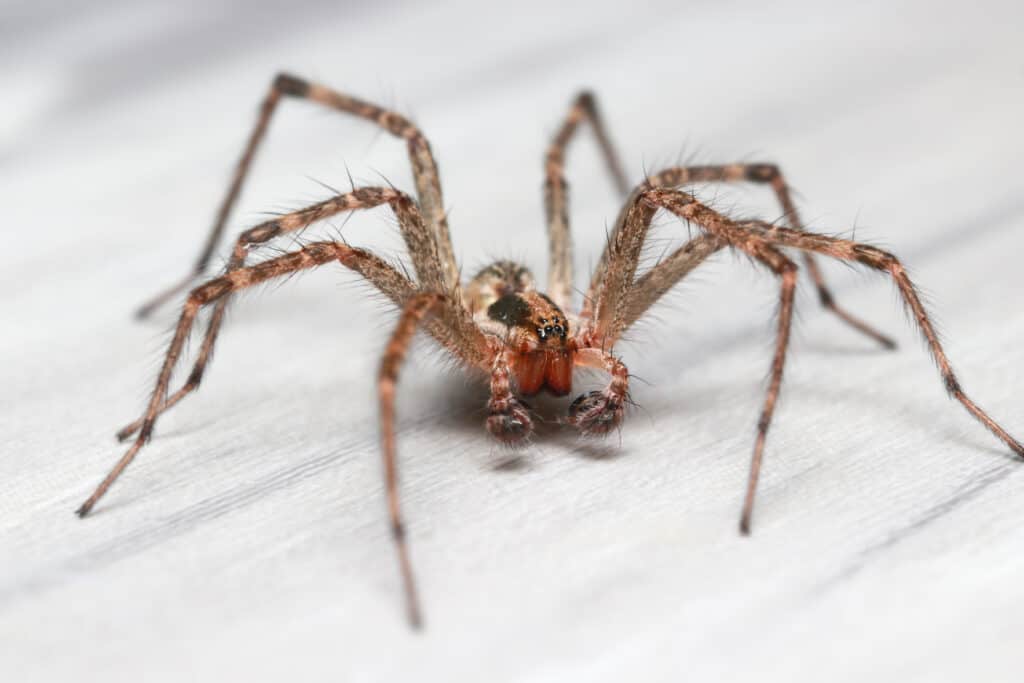
Hobo spider chilling on a white tabletop.
©SNEHIT PHOTO/Shutterstock.com
The hobo spiders in Fort Worth aren’t exactly homeless, especially if you find one (or more) inside the supposed comfort of your own home. Like the three previous spiders on our list, the hobo spider has a venomous bite. Like yellow sac spiders, hobo spiders are often confused with brown recluse spiders, due to their similar size and coloration.
Hobo spiders are lightning-quick and are capable of running up to a yard per second. They are not native to the state of Texas, originating from South America. However, they’ve set up shop successfully in the Lone Star State and look like they’re here to stay.
5. Brown Widow Spider
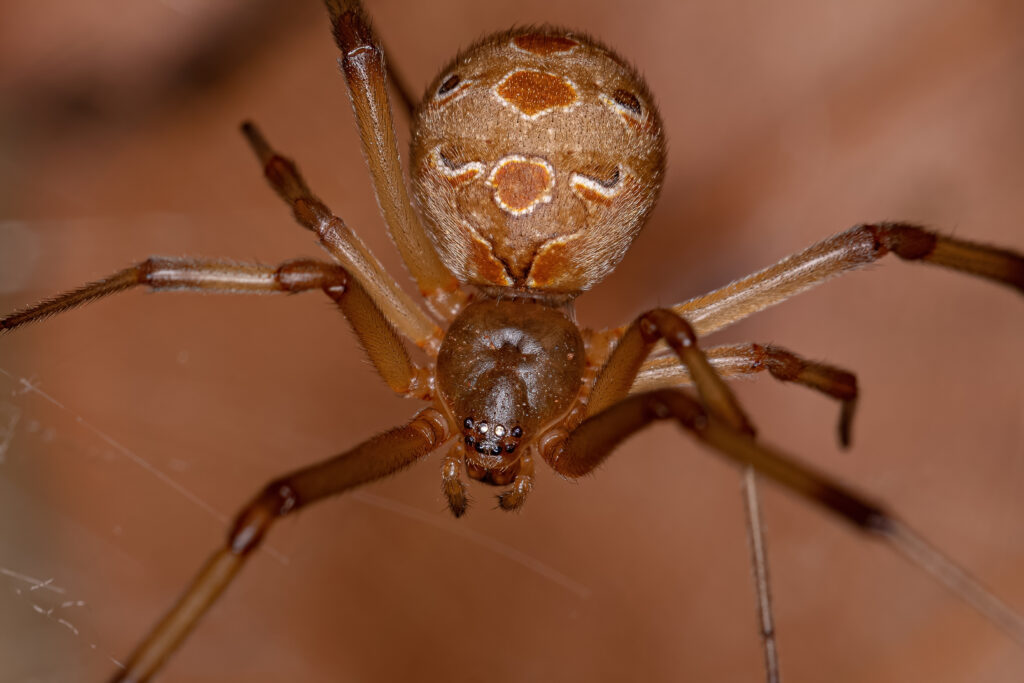
The brown widow spider looks quite devious.
©iStock.com/ViniSouza128
The existence of the black widow, and the malevolence behind its name, largely eclips the fact that there is also a brown widow spider. The good news is, the brown widow isn’t nearly as nasty and poisonous as the black variety. Like so many spiders in Fort Worth and around the United States, the brown widow is often confused with the brown recluse. This is due to its small size and brown body.
Also, like the brown recluse, the brown widow sets up its web in the dark corners of attics, dresser drawers, and bookshelves. All the places around the house where people stick their hands. They also like to hide out in shoes. Think about that one for a little while. The brown widow rarely bites, but the resulting wound is like that of a brown recluse.
6. The Orb Spider
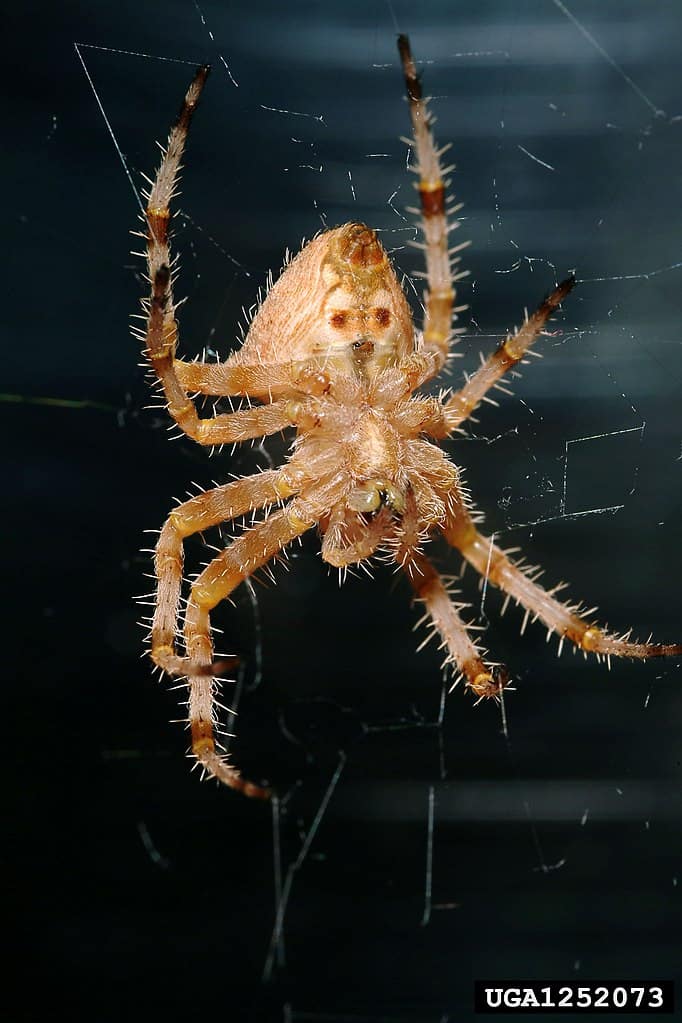
The Texas
orb weaver
is not only very large but also quite hairy.
©Joseph Berger, Bugwood.org; University of Georgia / Creative Commons – License
There’s nothing like a spider with a bulbous abdomen and a fuzzy exterior to give you the shudders. Despite how the fuzzy body masks the vividness of its coloration, the discerning observer will still catch hints of orange, red, and brown amidst the majority gray body.
Our list of spiders in Fort Worth mostly includes those that like to crawl around inside your home. However, the orb spider is just as happy in a garden. The garden is a good place to intercept insects, and orb spiders feed very well in abundant, thriving gardens. Unfortunately, like most arachnids, orbs tend to move to warmer locations when winter sets in.
7. Cellar Spider
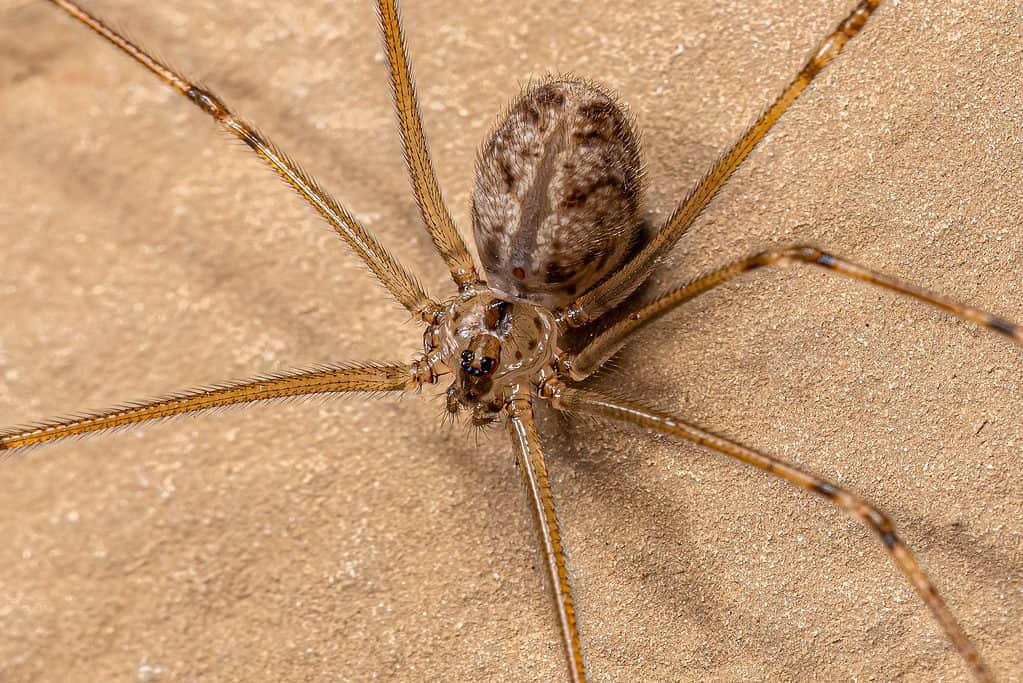
Short-bodied cellar spider, Physocyclus globosus.
©Vinicius R. Souza/Shutterstock.com
A cellar spider has all the creepy aesthetics of a daddy-long leg, with only a fraction of the leg length. They only grow up to a quarter inch, and, as the name implies, they prefer the warm dampness of a good cellar, basement, or garage. Like most of the spiders on our list, cellar spiders are venomous.
The good news is that cellar spiders aren’t known for biting anyone. Scaring the life out of people? Maybe. Biting? Not really. They are known for building enormous webs, which they add to as time goes on, over and over again. Eventually, your cellar or basement will be converted into a complicated mass of intricate webbing.
8. Crevice Spider
Crevice spiders are one of the largest species of spiders on our list. However, they are far from the largest spiders in the U.S., or even the world. About three-quarters of an inch long, these spiders hang out in cracks and crevices, blending in with their innocuous brown bodies.
Whether it’s masonry or wood, a crevice spider enjoys the safety of the cracks within these structures. However, they’ll settle for living on plants and the sides of walls that have no cracks. They are venomous, but the venom is not harmful to humans, and crevice spiders rarely bite.
9. Harvestman Spiders (Daddy Long Legs)
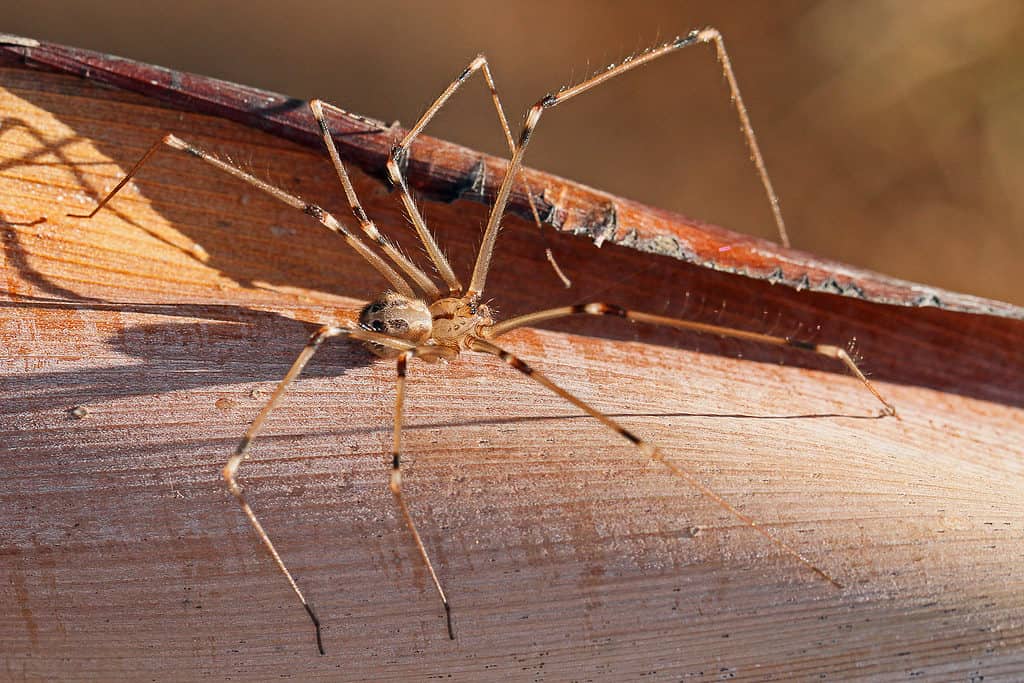
Close-up of a giant daddy long-leg spider.
©Eugene Troskie/Shutterstock.com
Of all the spiders in Fort Worth, the daddy long legs, or harvestman spider, is often layered in myth. Many inaccurately believe that the daddy long-leg spider is incredibly venomous, and has too small a mouth to bite humans. Not only is this inaccurate but it’s also directed at an opilionid, not a spider. You see, harvestmen aren’t true spiders.
Harvestman spiders are excellent for warding off other spiders because they eat them, along with aphids and a variety of other insects that are capable of ravaging your garden. If you have a backyard garden, the harvestman spider is your new best friend and should be allowed to go its way, undisturbed.
10. Wolf Spider
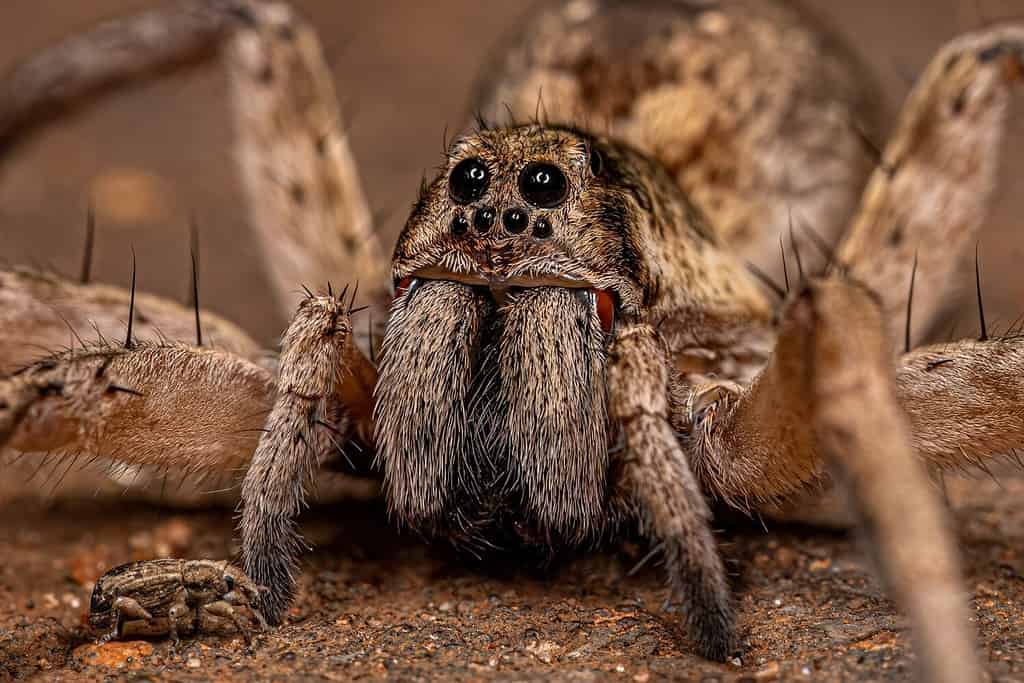
Zoomed in on a pic of the terrifying wolf spider.
©Vinicius R. Souza/Shutterstock.com
Wolf spiders in Fort Worth are a frightening sight. They don’t build webs but prefer to chase their prey around on the ground. Most of the time, this means running around in the dirt, hiding underneath leaves, and springing from the darkness to ambush their prey.
Like most spiders, wolf spiders find the idea of a nice, warm home where they can hunt in the corners of your closet, irresistible. They’re spooky spiders, incredibly fast, and they’re often spotted by the reflective glow of their eyes.
Species of Spider in Texas
While this is specifically about spiders in Fort Worth, there are over 900 species of spiders throughout the state. Texas is a huge state but, 900 species feel like a staggering number of spider types. That’s probably not information many Texans want to hear, either.
The information on the number of spiders in the Lone Star State is gathered and kept by Texas Parks and Wildlife, which also keeps up with the centipedes, scorpions, and everything else that walks, crawls, and slithers throughout the state.
Fortunately, only two of the 900 species are thought of as a direct threat to humans—the brown recluse and the black widow.
Recap of the 10 Spiders Crawling Around Fort Worth
| Spider Type | Description | Living Space |
|---|---|---|
| 1. Brown Recluse | Small, brown, with a violin shape on their abdomen | Love dark corners, such as dresser drawers, cabinets, under sinks, and closet corners |
| 2. Black Widow | Glossy black. Females have a red, hourglass shape on their abdomens | They love woodpiles, thick piles of leaves, cardboard boxes, shoes, old blankets, and dark corners |
| 3. Yellow Sac Spider | Similar to a brown recluse with a yellowish hue and no violin shape | Corners of walls throughout the house and where the walls meet the ceilings |
| 4. Hobo Spider | Resemble Daddy’s long legs with shorter legs and a darker, green/brown body and abdomen | Holes, cracks, and crevices where hobo spiders can create funnel webs |
| 5. Brown Widow | Brown, spindly legs with black bands at the joints and a grayish abdomen | Like black widows, they like wood piles, leaf piles, inside storage boxes, and exterior patio furniture |
| 6. Orb Spider | Fuzzy and gray, with orange, red, or brown splotches along the abdomen | Mostly outdoor spiders that prefer tall grass, leaf piles, wood piles, and trees |
| 7. Cellar Spider | Typically brownish in color but there are other shades as well | Dark, damp places like cellars, basements, beneath sinks, and behind water heaters |
| 8. Crevice Spider | Dark brown to regular brown with a thick body and legs | Typically brownish but there are other shades as well |
| 9. Harvestman Spider | Daddy long legs with long, very thin legs and a tiny, orb-like body | Harvestman spiders prefer to live in the garden, though they will come inside from time to time |
| 10. Wolf Spider | tannish brown with vertical, darker bands of brown and black. Smooth body with large legs | Outside in tall grass and leaves or inside in dark closets and seldomly used rooms |
Final Thoughts
Spiders in Fort Worth are plentiful and more than happy to invade your home for some warmth, food, water, and shelter. While the ten spiders on our list are a dime a dozen in the state of Texas, there are enough of them to make Fort Worth residents hesitant to reach their hands in dark places.
So long as you keep a clean house, seal your dry goods in the pantry, and clear out your closets and unused spaces periodically, you’ll drastically reduce the attractiveness of your home to these eight-legged arachnids.
The photo featured at the top of this post is © Vinicius R. Souza/Shutterstock.com
Thank you for reading! Have some feedback for us? Contact the AZ Animals editorial team.







